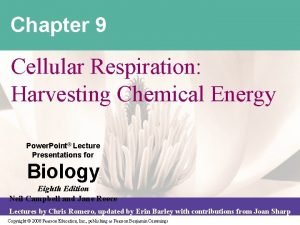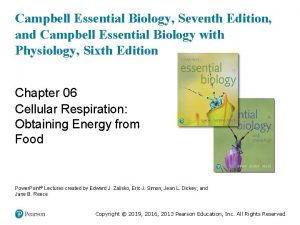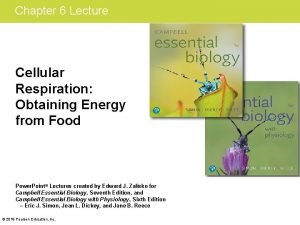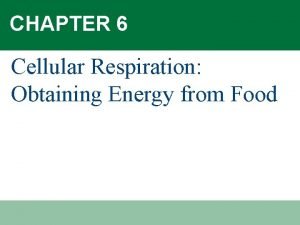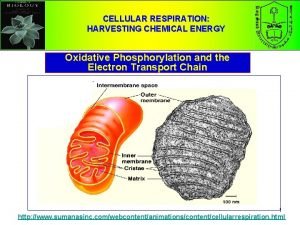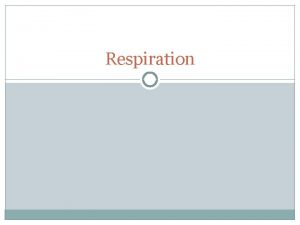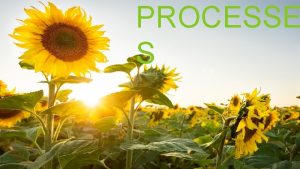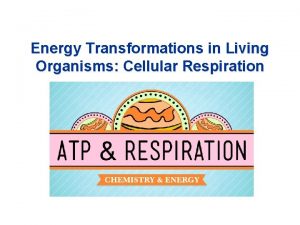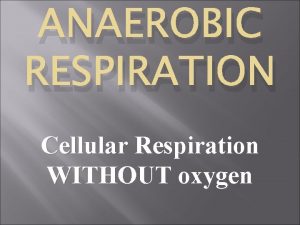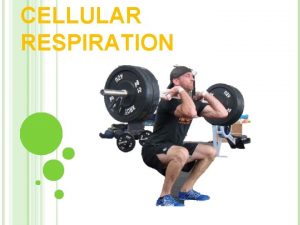LEC Energy Transformations in Living Organisms Cellular Respiration
















- Slides: 16

LEC: Energy Transformations in Living Organisms: Cellular Respiration Unit 3: Energy Transformations Chapter 9, Sections 1 & 2 (Pages 220 -232) Biology Science Department Deerfield High School

Review: Producers § Producers get their energy from the sun. § Producers convert this light energy into stored chemical energy (glucose). § This process is called photosynthesis. Biology Science Department Deerfield High School

Review: Consumers § Consumers get their energy from the producers. § Consumers convert stored chemical energy (glucose) into usable chemical energy (ATP). § This process is called cellular respiration. Biology Science Department Deerfield High School

Cellular Respiration (aerobic) § Cellular respiration is the process by which glucose (C 6 H 12 O 6) is broken down to release energy for making ATP, another form of chemical energy. Biology Science Department Deerfield High School

Aerobic Respiration – Equation C 6 H 12 O 6 + 6 O 2 food oxygen (glucose, a carbohydrate) Biology Science Department Deerfield High School 6 H 2 O + 6 CO 2 + 36 ATP water carbon dioxide

Bio. Theme: Interdependence! Photosynthesis: 6 H 2 O + 6 CO 2 + energy (sun) → C 6 H 12 O 6 + 6 O 2 Aerobic Cellular Respiration: C 6 H 12 O 6 + 6 O 2 → 6 H 2 O + 6 CO 2 + energy (ATP) Biology Science Department Deerfield High School

Why ATP? An analogy to money… § Glucose in our food is a great source of energy! ($100 bill) § However, individual cell processes may only require a small amount of energy ($1 bill) § Analogy: most vending machines do not accept $100 bills! We need a smaller form of “currency” for these processes. § ATP (adenosine triphosphate) is this important cellular “currency” for life. § ATP releases more appropriate amounts of energy for the individual cellular processes that require energy. (We will study this molecule in detail in our next activity!) Biology Science Department Deerfield High School

The BIG Question is… Do only animals respire? Or do plants respire too? § Only plants perform photosynthesis § Plants AND animals perform cellular respiration! (Can you explain why? ? ) Biology Science Department Deerfield High School

Site of Cellular Respiration § Plant and animal cells contain mitochondria: cell structures that transform chemical energy from glucose to ATP. Biology Science Department Deerfield High School

Significant ATP Production § Aerobic cellular respiration releases energy SLOWLY, using oxygen to convert ONE molecule of glucose to 36 ATP! Biology Science Department Deerfield High School

Cellular Respiration (anaerobic) § What happens when cells don’t have enough oxygen? § Some organisms live in an oxygen-free environment. How do they get their energy? Biology Science Department Deerfield High School

Cellular Respiration (anaerobic) § Anaerobic respiration is also called fermentation, or the process by which energy is released from glucose when oxygen is NOT available. § This process allows organisms to continue to produce energy until oxygen is available. § However, this process only releases 2 ATP per molecule of glucose. Biology Science Department Deerfield High School

Alcoholic Fermentation § Anaerobic way of converting energy for yeast and other microorganisms § Glucose broken down to produce alcohol, CO 2 and energy (ATP) § C 6 H 12 O 6 ethanol + CO 2 + 2 ATP § EX: baking bread with yeast fermenting wine & beer Biology Science Department Deerfield High School

Lactic Acid Fermentation § Anaerobic way of converting energy in animal cells and some microorganisms § Glucose broken down to produce lactic acid, CO 2 and energy (ATP) § C 6 H 12 O 6 lactic acid + CO 2 + 2 ATP § EX: muscle cells during strenuous exercise fermenting cheese, yogurt, sour cream Biology Science Department Deerfield High School

Strenuous Exercise § Lactic acid is produced by your muscle cells during rapid exercise when the body cannot supply enough O 2 to tissues. § Without enough O 2, the body is NOT able to produce all of the ATP that is required. § The buildup of lactic acid can cause painful burning in your muscles! Biology Science Department Deerfield High School

Comparing ATP Production § First, your body breaks down glucose through aerobic respiration to produce 36 ATP per glucose molecule; however, this is a slow process. § When muscle cells cannot get enough O 2 they break down glucose through lactic acid fermentation to produce 2 ATP per glucose… § Therefore, AEROBIC RESPIRATION is Biology much more efficient in terms of ATP production – 36 ATP compared to 2 Science Department Deerfield High School
 Section 1 how organisms obtain energy
Section 1 how organisms obtain energy Pyramid hesd
Pyramid hesd Chapter 9: cellular respiration: harvesting chemical energy
Chapter 9: cellular respiration: harvesting chemical energy Energy flow in cellular respiration
Energy flow in cellular respiration Consumer
Consumer Chapter 9 cellular respiration harvesting chemical energy
Chapter 9 cellular respiration harvesting chemical energy Chapter 9: cellular respiration: harvesting chemical energy
Chapter 9: cellular respiration: harvesting chemical energy Cellular respiration obtaining energy from food
Cellular respiration obtaining energy from food Cellular respiration obtaining energy from food
Cellular respiration obtaining energy from food Phosphorelation
Phosphorelation Cellular respiration redox
Cellular respiration redox What is the correct equation for cellular respiration?
What is the correct equation for cellular respiration? Chemiosmosis steps
Chemiosmosis steps Types of respiration
Types of respiration Why is cellular respiration important
Why is cellular respiration important Why is cellular respiration important
Why is cellular respiration important Complimentary processes
Complimentary processes



